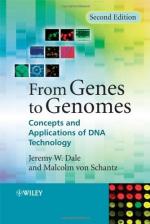|
This section contains 342 words (approx. 2 pages at 300 words per page) |
Recombinant deoxyribonucleic acid (DNA) is genetic material from different organisms that has been chemically bonded together to form a single macromolecule. The recombination can involve the DNA from two eukaryotic organisms, two prokaryotic organisms, or between an eukaryote and a prokaryote. An example of the latter is the production of human insulin by the bacterium Escherichia coli, which has been achieved by splicing the gene for insulin into the E. coli genome such that the insulin gene is expressed and the protein product formed.
The splicing of DNA from one genome to another is done using two classes of enzymes. Isolation of the target DNA sequence is done using restriction enzymes. There are well over a hundred restriction enzymes, each cutting in a very precise way a specific base of the DNA molecule. Used singly or in combination, the enzymes allow target segments of DNA to be isolated. Insertion of the isolated DNA into the recipient genome is done using an enzyme called DNA ligase.
Typically, the recombinant DNA forms part of the DNA making up a plasmid. The mobility of the plasmid facilitates the easy transfer of the recombinant DNA from the host organism to the recipient organism.
Paul Berg of Stanford University first achieved the manufacture of recombinant DNA in 1972. Berg isolated a gene from a human cancer-causing monkey virus, and then ligated the oncogene into the genome of the bacterial virus lambda. For this and subsequent recombinant DNA studies (which followed a voluntary one-year moratorium from his research while safety issues were addressed) he was awarded the 1980 Nobel Prize in chemistry.
In 1973, Stanley Cohen and Herbert Boyer created the first recombinant DNA organism, by adding recombinant plasmids to E. coli. Since that time, advances in molecular biology techniques, in particular the development of the polymerase chain reaction, have made the construction of recombinant DNA swifter and easier.
Recombinant DNA has been of fundamental importance in furthering the understanding of genetic regulatory processes and shows great potential in the genetic design of therapeutic strategies.
|
This section contains 342 words (approx. 2 pages at 300 words per page) |


